- DAIMYO FLAGS (or DAIMO FLAGS)
- 1) Generically, a term for those flags that were in use prior
to the Japanese Imperial restoration of 1868/71 – a nobobi, hata-sashimono / sashimono
and/or uma-jirushi – but see notes below (also (also
‘hinomaru’ and ‘mon’)
- 2) Specifically, a term that refers to the personal and war flags of Japanese feudal lords,
and in use until the 17th Century.
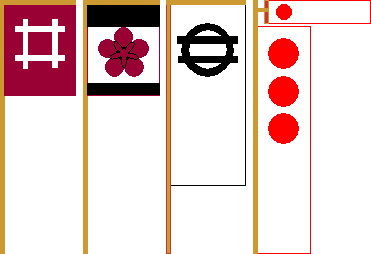
Notes
a) With regard to 1), the varying types of (historical) Japanese
flag are in the process of detailed classification, and the terms given above
have been limited to those in general use.
b) Thesashimono” and “uma-jirushi”, whilst currently employed to
describe flags, can also refer to a vexilloid - see ‘vexilloid 2)’.
- DANCETTY (or DANCETTÉ)
- The heraldic term used when an ordinary such as a fess, bend or pale, or the line of a
division on a shield, banner of arms or flag, is saw-toothed – dancetté, dentelé or
dentilly - but see indented and ‘serrated’ (also
‘ordinary’,
‘stepped’
and ‘wolfteeth’).

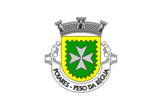
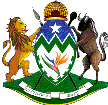
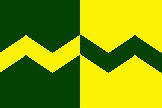
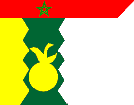
Arms and Flag of Poiares e Canelas, Portugal (fotw); ; Arms of
KwaZulu-Natal, South Africa (fotw);
Flag of Castro de Filabres, Spain (Klaus-Michael Schneider); Flag of
Tetouan 196876, Morocco (fotw)
- DANGER FLAG
- See ‘red flag 1)’.
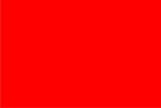
- DANNEBROG
- Literally “Danish-cloth”, and the current national flag of Denmark. (see also
‘splittflag’)
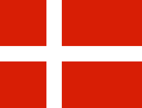
National Flag of Denmark (fotw)
- DE FACTO
- 1. (adj) A generally employed Latin term for ‘in practice’, and used in vexillology
to indicate flags in actual use as opposed to those as laid down by law or regulation
(see also ‘de jure’ and the note below).
- 2. (adj) A term sometimes employed to describe a flag which is in use, but which has not
been officially established by law or regulation – but see note below de jure (also
unofficial flag).
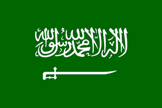
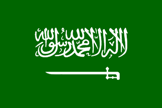
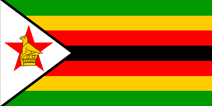
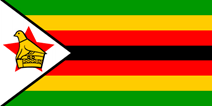
The Reverse of the National Flag of Saudi Arabia in some De Facto use (fotw);
The Reverse of the National Flag of Saudi Arabia as regulated; National Flag of
Zimbabwe in some De Facto use, and as regulated.
- DE JURE
- (adj) A generally employed Latin term for ‘in law’, and used in vexillology
to indicate a flag as laid down by law or regulation, as opposed to those in actual
use (see also ‘flag law’,
‘de facto’,
official flag 1),
‘specification sheet’,
and the notes below).
Notes
a) It is suggested that the above terms
should not be used when describing a flag for which no known official specifications
exist, therefore, no de jure design from which a de facto flag may differ, and
under these circumstances we recommend that the term “variant” be employed - see
‘variant 2)’.
b) An example of de jure as opposed
to de facto is the proportions of the Belgian national flag which is regulated
at 13:15, but which is most often see in practice with the civil ensign ratio of 2:3.
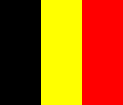
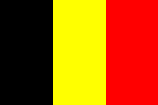
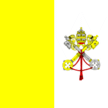
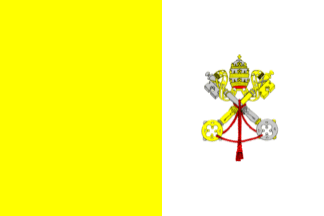
National Flag of Belgium as regulated, plus the Civil Ensign of Belgium as regulated
(which is also the de facto National Flag); National Flag of the
Vatican as regulated, and the
unofficial 2:3 version actually flown
- DEBASED
- See ‘reversed 2)’.

- DEBRUISED
- A heraldic term used in place of ‘surmounted by’ particularly when a charge or ordinary (which may or may not touch the field) is being placed over an animal – but see ‘surmounted, by’ (also ‘charge 1)’,
‘ensigned’, ‘ordinary’ and ‘overall 2)’).
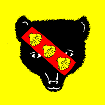

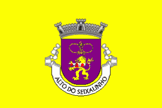
Flag of L’Abbaye, Switzerland (fotw); Arms and Flag of
Alto do Seixalinho, Portugal (fotw)
- DECK FLAGS
- A term to describe the practice, now obsolete, of showing a display of flags along the
deck of a ship as illustrated below see
pavisade and
streamer 2) (also
ancient and
postures).
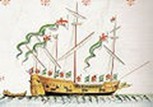
The Salamander, English Royal Navy c1525 (Wikipedia)
- DECKING
- A term for the custom of foot guards in British and Canadian service of placing
a garland or chaplet of laurel – a crown triumphal - at the top of the regimental
colour pike or staff on days of significance in regimental history (see also
‘colour 2),
‘colours 2)’,
‘crown triumphal’,
‘garland’,
‘pike’,
‘staff 2)’ and
‘wreath of immortelles’).
- DECOMMISSIONING PENNANT
- See ‘paying off pennant’.
- DECORATED
- See ‘garnished’.
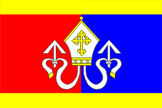
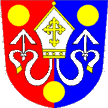
Flag and Arms of Častrov, Czech Republic (fotw)
- DECRESCENT (or DECREMENT)
- See ‘moon 2)’ with following note.
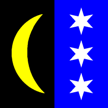
Flag of Schinznach, Switzerland (fotw)
- DEFACE
- 1. (v) In UK usage and some others, a term for the addition of any authorised
(or apparently authorized) emblem, badge, shield, charge or device to a flag
(see also
‘archivexillum’,
‘badge’,
‘charge’,
'defaced', 'device',
‘emblem’
‘shield’ and
undefaced).
- 2. (v) In US usage and some others, the term may also be used to include any unauthorized addition – but see note below.
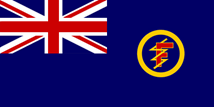
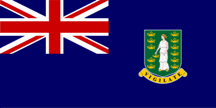
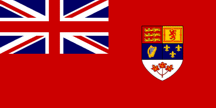
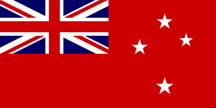
Ensign of the Training Ship Foudroyant c1817 1897 (fotw);
Flag of the British Virgin Islands (fotw);
Canadian Red Ensign 1957 1965 (fotw);
Civil Ensign of New Zealand (fotw)
Please note that in heraldry and vexillology the
term has no pejorative connotation (but see also
‘desecrate’ and/or
disfigure).
- DEFACED
- (adj) The term used to describe a flag which is often flown plain, but in
this case is seen with an authorized addition (see also
archivexillum,
blue ensign,
deface 1),
red ensign
undefaced and
warrant).
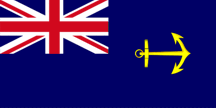
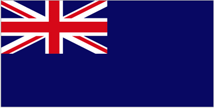
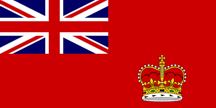
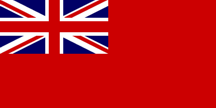
From left: Defaced Government Service Ensign, UK; Undefaced Reserve Ensign, UK (fotw);
Defaced Royal St George Yacht Club, UK, Undefaced Civil Ensign, UK (fotw)
- DEMI (or DEMY)
- The heraldic term used when the front or upper half of an animal, or one-half of another charge is shown on a shield,
banner of arms or a flag but see note below – demy or semi.
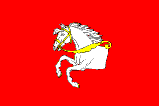
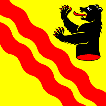
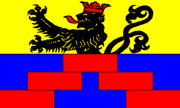
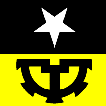
Flag of Pardubice, Czech Republic (fotw); Flag of
Romoos, Switzerland (fotw); Flag of
Rόgen, German (fotw);
Flag of Gurtnellen, Switzerland (fotw)
Notes
a) One-half of an animal or other charge that is placed
against the centre line of a shield, banner of arms or a flag, is said to be
‘dimidiated’.
b) This term is never used alone, but always
with the charge being so described – for example a demi-horse as shown above or a demi-eagle displayed as seen below.
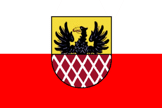

Flag of Cheb, Czech Republic (fotw)
- DEMONSTRATION BANNER
- See ‘banner 3)’.
- DENTELÉ (or DENTILLY)
- See ‘dancetty’ (also ‘serrated’).
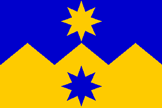
Flag of Otago, New Zealand (fotw)
- DEPARTMENT PENNANT
- See ‘service pennant’.
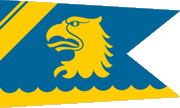
Departmental/Service Pennant, Coastguard, Sweden (fotw)
- DEPARTMENTAL EMBLEM
- See emblem military and governmental/departmental under emblem.
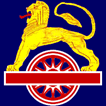
Emblem of emblem military and governmental/departmental (fotw)
- DEPTH
- See ‘width 1)’.
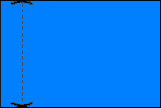
- DESCATE
- (adj) A term used to describe a rounded (or lanceolate) fly into which a ‘V’ shaped notch
has been cut, and a shape often seen in UK cavalry guidons – cloven descate or
rounded swallowtail (see also
‘fly 1)’,
‘guidon 2)’,
‘hussar cut’,
‘lanceolate’,
‘pennant’ and
‘swallow tail(ed)’).
![[descate flag]](../images/v/vxt-d1189.gif)
![[descate flag]](../images/v/vxt-d2118.gif)
Guidon of the Metropolitan Police Mounted Branch, UK (Herman FMY);
Guidon of the Blues and Royals, UK (Graham Bartram/Željko Heimer)
In UK usage this pattern of flag/pennant is a direct development of the shape formerly carried by formations of cavalry
- see chamfered swallow-tail.
![[descate flag]](../images/v/vxt-d2119.gif)
Guidon of the Royal Gloucestershire Yeomanry 1797, UK (fotw)
- DESCENDING DIAGONAL
- 1) The term for a diagonal stripe that runs from the upper hoist to the
lower fly, and is centred on the corners of the flag – a bend, falling
diagonal, hoist-diagonal, right diagonal or right diagonal bar - but see ‘bend’ and
Appendix IX (also
‘ascending diagonal’,
‘east-south diagonal’,
‘east-west diagonal’,
‘north-east diagonal’,
‘north-south diagonal’,
‘south-east diagonal’,
‘south-north diagonal’,
‘west-east diagonal’,
‘west-north diagonal’,
and ‘west-south diagonal’.
- 2) The term may also be used to describe the division line on a bicolour
divided diagonally per bend as shown below – see ‘per bend 1)’
(also ‘bicolour 1)’).
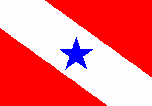
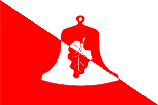
Flag of Pará, Brazil (fotw); Flag of Rašov, Czech Republic (fotw)
- DESECRATE
- 1) (v) To maliciously damage or mistreat a flag for political or other motives, or to use a flag in a way that is
considered disrespectful or inappropriate (see also ‘rules of respect’ and
‘Appendix II’).
- 2) See ‘disfigure’.
- DESIGNATING (OF HEADQUARTERS) FLAG
- See ‘headquarters flag 2)’.
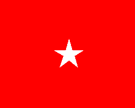
Designating/Headquarters Flag of a Brigadier General, US Army (fotw)
- DESK FLAG (or DESK TOP FLAG)
- See ‘table flag’.

Desk/Table Flag of Gracice, Croatia (fotw and CS)
- DESTINATION FLAG
- The term describing a custom whereby the flag of the country of destination
may be flown at the fore by a merchant ship or pleasure vessel
when about to sail (see also ‘fore’).
- DEVICE
- 1) Originally a heraldic term for a temporary mark extra to the coat of arms
to distinguish those who entered the lists at tournaments, it now refers specifically
to the ‘motto (see ‘motto’).
- 2) The term used to describe those marks of difference that appear on English military
colours of the 17th Century (see also stand 1)’ and
venn).
- 3) A term sometimes inaccurately applied to any charge, badge or emblem (see
also ‘badge’,
‘charge’ and
‘emblem’).
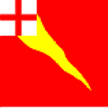
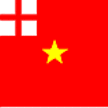
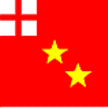
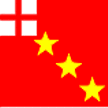
Majors then First, Second and Third Captains Colours,
Westminster Liberty Regiment, London. England c1641 (fotw)
- DEXTER
- The heraldic term for the right hand side of a flag or shield from the point
of view of the bearer, or the left hand side from the point of view of an observer
(see also ‘sinister’).

- DEXTER EDGE
- 1) With regard to a shield see ‘dexter’ above.
- 2) A term that may be used in describing the left hand facing edge of a banner or
gonfalon which is hung from a crossbar, and equivalent to the top edge of a conventionally
hoisted flag – the leading edge (see also
‘banner 2)’ and
‘gonfalon’).

- DEXTER HOIST (HOISTED or HOISTING)
- A rarely employed term, but one that may be used when the obverse of a flag is depicted (or is
manufactured) with its hoist to the observer’s left in accordance with Western tradition –
left hoisted - see
‘dexter’ and
‘sinister hoist’
(also ‘hoist 1)’,
‘obverse’ and
‘reverse’).
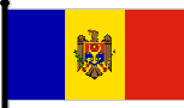
National Flag of Moldova (fotw)
Please note, it is usually felt unnecessary to specify the dexter hoist since it is a default assumption
in most cases.



































![[descate flag]](../images/v/vxt-d1189.gif)
![[descate flag]](../images/v/vxt-d2118.gif)
![[descate flag]](../images/v/vxt-d2119.gif)


















